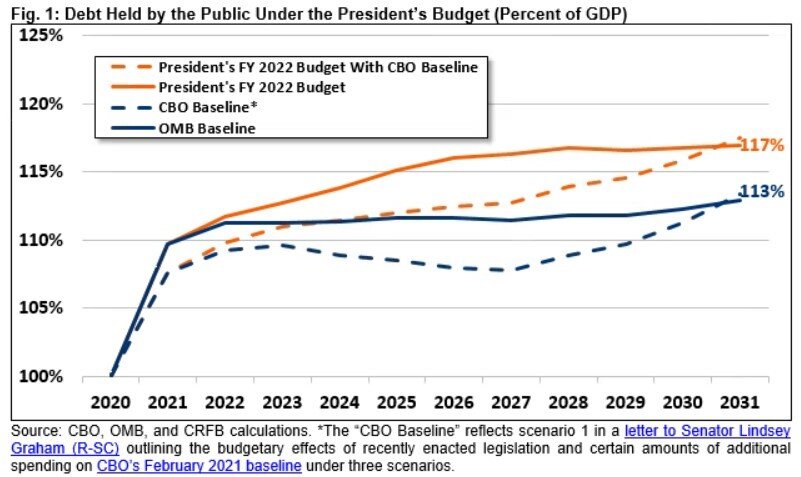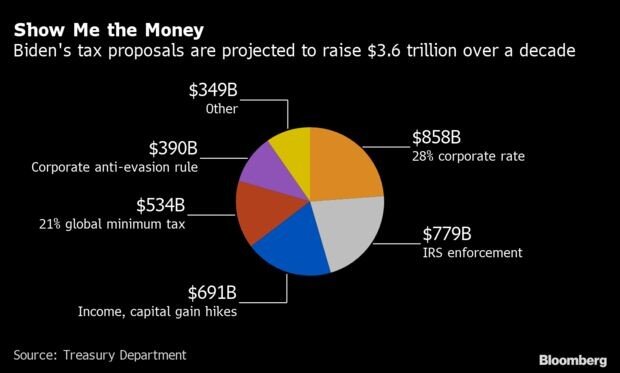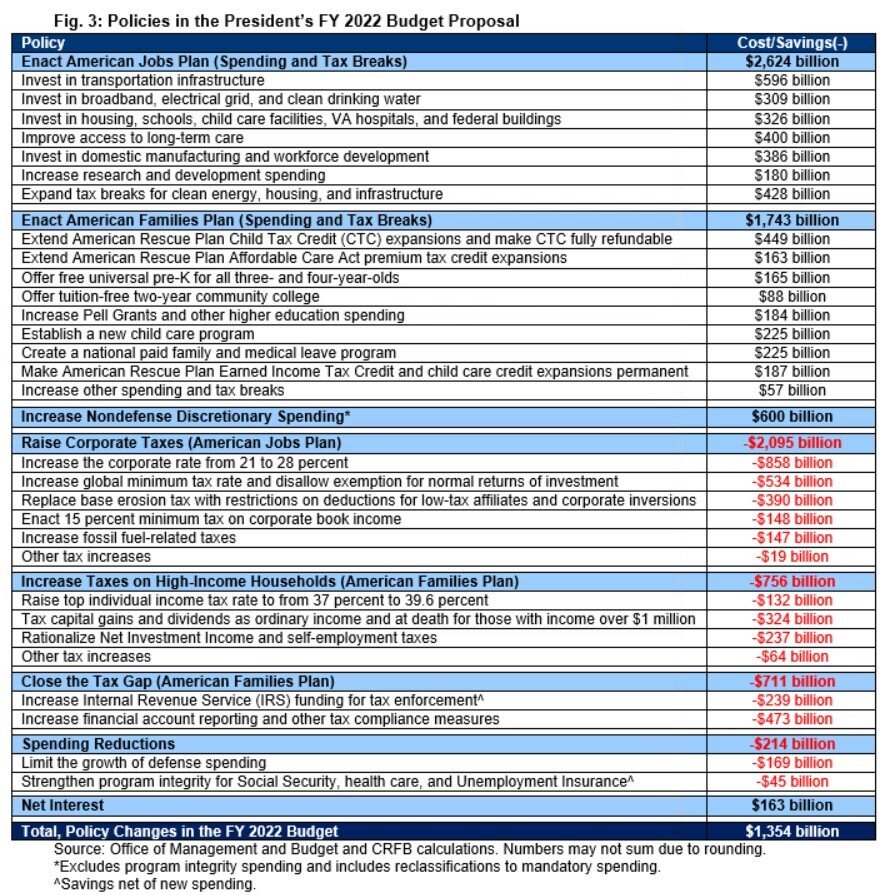This is the first in a series of reports on President Biden’s proposed fiscal year 2022 budget. Your CRD Associates team will provide you with more in-depth analyses of the budget request as details become available.
As was evident when it first outlined a “skinny” budget back in early April, the Biden administration is seeking massive funding increases for a host of health, education and environment programs, while essentially maintaining current spending levels on defense and homeland security.
The 1,700-page fiscal year 2022 budget proposal unveiled May 28 tops $6 trillion and kicks off the annual negotiation process between the president and Congress to determine how best to distribute federal funds across the government. President Biden’s blueprint calls for dramatic investments to bolster the country after the coronavirus pandemic by increasing spending more than 10 percent in 11 of the 15 Cabinet departments—a dramatic change from proposals by the Trump administration, which often sought to cut spending for many agencies.
Biden’s plan includes an array of proposals aimed at helping vulnerable populations, including disadvantaged students and the homeless while, for defense, his budget is below both Obama’s and Trump’s.
Notably absent in the budget proposal is President Biden’s campaign promise to enact a public option to establish a government-run health insurance plan and his pledge to cut prescription drug costs. Other items left out of the plan are proposals to raise the estate tax and forgive large amounts of student debt.
To build its case for new spending, the administration predicts the economy will grow at just under 2 percent per year for most of the next decade, once inflation is factored in. The administration also makes clear it does not share fears espoused by some on Wall Street of rapid inflation, predicting consumer prices would never rise faster than 2.3 percent per year. The budget predicts a quickly rebounding labor market, with unemployment falling to 4.1 percent—from 6.1 percent today—by next year and remaining below 4 percent over the rest of the coming decade.
On the other side of the ledger, Biden’s budget never balances, projecting annual deficits above $1.3 trillion for the next 10 years and a national debt that hits $39 trillion, or 117% of annual economic output, by 2031

Critics argue that while it offsets new spending priorities over time and reduces deficits in future decades, the Biden’s budget adds too much to the debt over the next ten years, and does too little to address high and rising debt over the long term.
BUDGET GOES BIG ON SCIENCE
As part of its boost in domestic spending, the budget proposal includes significant increases for federal research agencies.
- The National Institutes of Health (NIH) would grow by $9 billion, to $51 billion, including $6.5 billion for a new entity, the Advanced Research Projects Agency-Health (about as much annual funding as the National Cancer Institute received in FY 2021), and $110 million to fund research on climate change and human health.
- The National Science Foundation would get a 20 percent boost, to $10.2 billion. Within that total, an unspecified amount would go to a new directorate to foster emerging technologies.
- The Department of Energy’s Office of Science would grow by $400 million, to $7.4 billion. The president has also proposed a new unit, the Advanced Research Projects Agency-Climate (ARPA-C). The request says ARPA-C and a similar entity for energy, ARPA-E, would have a combined budget of $1 billion.
- NASA would receive a 6.3 percent increase, to $24.7 billion, including a $250 million boost in the earth sciences program and a $20 million increase, to $147 million, for science education.
- The National Institute of Standards and Technology (NIST) would get a big boost to both its research and industrial programs. Spending on NIST’s research labs would grow by $124 million, to $916 million, and its investment in a network of manufacturing institutes would more than double, to $442 million.
- The budget of the National Oceanic and Atmospheric Administration would grow by $1.4 billion, to $6.9 billion, including $800 million to expand investments in climate research.
- The Environmental Protection Agency would receive a 21 percent, $2 billion increase, to $11.2 billion, with a portion of the funds targeted on boosting agency staffing levels and enforcement efforts.
- The U.S. Department of Agriculture’s spending on research, education, and outreach would jump by $647 million, to $4 billion.
TAXES IN THE CROSS HAIRS

On the tax front, Biden’s budget proposes to roll back most of the Trump cuts on the corporate and international side of the tax code, including bringing the corporate rate back to 28 percent and the top individual rate back to 39.6 percent.
The proposal allows many temporary Trump tax cuts for individuals and families to expire, as they are already slated to do after 2025. However, doing so amounts to something of a budgetary gimmick, as it allows Biden to bank the savings from higher tax rates snapping back in place on families making less than $400,000 per year.
- The budget does not address the state and local tax deduction; moderate Democrats from high-tax states have pushed the White House to expand the deduction that Trump’s 2017 tax overhaul restricted to $10,000.
Biden’s budget proposal assumes Congress will enact an increase in the capital gains rate retroactive to April 2021, preventing the wealthy from quickly selling off their assets before the end of the year to avoid the hike. Most of the other increases, if approved by Congress, would start on January 1, 2022.
A PACKED SUMMER SCHEDULE
The budget proposal adds yet another item to the congressional to-do list as Democratic leadership and the Biden administration scramble to get key parts of their legislative agenda passed amid a raft of deadlines and procedural hurdles, including:
- May 31: The Biden administration has previously pointed to Memorial Day as a soft deadline to determine if Senate Republicans are willing to compromise on infrastructure.
- June: The House plans to spend much of this month on passing a budget and continuing work on appropriations bills, with another budget reconciliation process in the offing.
- July 4: Speaker Nancy Pelosi (D-CA) is publicly aiming for passage of President Biden’s infrastructure plan before the Independence Day recess, though some congressional Democrats are suggesting that deadline may slip.
- August: Senate Majority Leader Chuck Schumer (D-NY) is pledging to bring Senate Democrats’ signature elections and public ethics bill, S. 1, to the floor by August.
- September 6: Democrats must reach an internal consensus on the fate of pandemic-related unemployment benefits, with a $300 per week expansion in federal unemployment insurance set to expire, and some moderate members opposed to extending or making permanent the expanded benefit.
- September 30: Democratic leaders will also need keep their rank-and-file in line to avert a showdown over the federal budget and the debt ceiling by September. While the drop-dead date for the Treasury Department’s extraordinary accounting measures to be exhausted is not set, analysts agree the statutory debt limit will be reached around late August or September, and September 30 is when current government funding expires.
Despite all the deadlines, the House is slated to be in session for just five weeks before the start of the August recess. The Senate is scheduled to stay in session through the first week of August.
BUDGET HIGHLIGHTS

Following are the highlights of President Biden’s budget proposal for selected departments and agencies.
AGRICULTURE
The Biden administration proposes a nearly 17 percent increase in base discretionary funds to the USDA, to $27.9 billion. In general, the USDA budget proposal is heavily weighted towards rural communities, with increased funding for water infrastructure and nutritional safety net programs. Biden’s proposal displays several of his administration’s top priorities, including tackling the coronavirus pandemic and climate change. The president also called on lawmakers to expand broadband access, push farmers to use cleaner energy, invest in research for farming technology, and ensure more equitable farm programs. Other highlights include:
- $1 billion in increased funding for food assistance programs.
- Funding for infrastructure priorities such as rural broadband access and safe drinking water.
- $1.4 billion more for rural clean energy development.
COMMERCE
Funding for the Commerce Department is heavily focused on research into climate change, with a significant increase proposed for the National Oceanic and Atmospheric Administration for climate research and aid to regional and local areas to support climate data and tools.
The budget plan also seeks to bolster Commerce’s ability to help U.S. companies develop semiconductors and other items of strategic national significance as well as aid to minority-owned businesses.
DEFENSE
The president’s proposal for the Pentagon is $715 billion, an increase of 1.7 percent in overall spending. Progressives had argued for cuts of at least 10 percent, while Republican leaders want defense increases to equal those for social programs.
The Pentagon is seeking to boost research and development of new technologies such as artificial intelligence, microchips, and hypersonic weapons in its proposed budget, shifting toward deterring China and Russia and away from decades-long counterterrorism operations in the Middle East. The Defense Department is asking for an unprecedented $112 billion for research and development in fiscal year 2022, or a 5 percent increase from this year’s $106.6 billion request. Other highlights include:
- Continued investments in building up the Navy in order to reassure allies and signal U.S. resolve to potential adversaries.
- “Divesting legacy systems,” i.e. eliminating older military equipment.
- Prioritizing climate change, with funds set aside to make military installations more resilient.
- President Joe Biden’s upcoming budget request will propose growing U.S. Cyber Command’s main digital warfighting force over the next two years. Biden wants to increase the size of the Cyber Mission Force — a cadre of roughly 6,200 personnel culled from the military branches and divided into 133 teams — by about 600 people, or 10 percent.
EDUCATION
Biden’s proposal would expand the federal investment in education to $102.8 billion, up $29.8 billion, or nearly 41 percent, over current funding levels.
The total includes the largest ever annual increase–$20 billion—for Title I programs to aid disadvantaged students. This would be in addition to the $122 billion for K-12 schools contained in the recently enacted rescue act.
For postsecondary education, the budget proposes $33 billion, including a $400 increase in the maximum Pell grant award, now at $6,495. Roughly 7.3 million students will receive some form of assistance from Pell Grants in 2022. Under Biden’s proposal, so-called “dreamers” who came to the U.S. illegally would also be eligible. Highlights of the education budget include:
- A $2.6 billion increase in special education services, bringing the federal contribution to $15.6 billion, or about 15 percent of the total costs.
- A ramp-up of funding for community schools and a new $100 million grant program to promote racial and economic desegregation.
ENERGY
The president’s budget proposes $46.2 billion for the Energy Department, an increase of $4.3 billion, or 10 percent. Most of the budget goes to maintaining the nation’s nuclear weapons arsenal, with the remainder targeted on running supercomputers and studying alternative forms of producing energy. The budget request details the president’s long-term goal to reach carbon neutrality in 30 years, but in the near-term, it includes a funding boost as part of a revamp of the office that focuses on carbon-intensive fuels. The renamed Office of Fossil Energy and Carbon Management—currently Fossil Energy Research and Development—would receive $890 million under the request, an 18.7 percent increase from fiscal 2021. Funding research and other activities related to both carbon-intensive fuels and de-carbonization matches what Energy Secretary Jennifer Granholm told House appropriators earlier this month. Other highlights include:
- A total of $8 billion to develop the next generation of nuclear reactors, electric vehicles and other alternatives to fossil fuels.
- The budget includes $1 billion for two start-up incubators to support technological breakthroughs in combating climate change.
- Boosting Office of Science funding by $400 million, to $7.4 billion, to support basic science research at national laboratories across the U.S.
HEALTH AND HUMAN SERVICES
Arguing that the COVID pandemic underscored the need to strengthen the nation’s public health infrastructure, the Biden proposal calls for $133.7 billion for HHS, an increase of more than 23 percent over current funding.
The budget proposes new investments to combat the opioid epidemic; higher funding to address racial disparities in health care; ramping up the fight against HIV/AIDS; new research into the health effects of gun violence and climate change; and efforts to reduce the risks of childbirth. Highlights include:
- An additional $9 billion in funding for NIH, including $6.5 billion to set up the Advanced Research Projects Agency for Health (ARPA-H), which would initially focus on cancer and diseases such as Alzheimer’s and diabete. Key House lawmakers are already in talks with the White House about using upcoming Cures 2.0 legislation as a vehicle for authorizing ARPA-H, which would bring together the government, private sector and academia to research new therapies for diseases.
- An increase of $1.6 billion for the CDC—the largest annual jump in nearly two decades—to head off the next pandemic.
- A funding increase of $3.9 billion for new grants and other resources for states battling the opioid crisis.
- The budget drops Hyde amendment language, a longstanding appropriations measure that has blocked federal funding for abortions, except in the case of rape, incest, or to save the life of the woman.
STATE AND USAID
In an effort to reinvigorate the government’s diplomatic muscle, President Biden’s budget proposal calls for a nearly 12 percent boost at the State Department and USAID, bringing total funding to $63.5 billion. Global health programs would see an $855 million boost to $10.1 billion as the administration seeks to help countries address damage from the Covid-19 pandemic. Other proposed changes include:
- $1.2 billion to help developing countries reduce carbon emissions through the international Green Climate Fund.
- $861 million in aid to Central America, aimed at lessening the root causes of migration to the U.S.
- An added $1 billion for global health security intended to bolster research to detect and stop future infectious disease outbreaks.
TRANSPORTATION
The Biden administration is proposing $25.7 billion—a nearly 15 percent increase—in the Transportation Department’s discretionary funding, plus another $62 billion for mandatory programs. New programs are being proposed to promote equity in transportation, address climate change and incentivize rail travel between cities. Budget highlights include:
- The budget proposes a new $625 million competitive grant program to promote passenger rail as a low-carbon option for intercity travel.
- A 35 percent boost, to $2.7 billion, for Amtrak.
- A 23 percent boost—to $250 million—for grants to increase purchases of buses with zero or low emissions.
- The budget also calls for $2.4 billion over three years for the U.S. Postal Service to electrify its fleet of vehicles.